Many people are interested in Norse mythology. Some are just starting to learn about it and are in need of introductory resources.
Others already have some basic knowledge on the topic and are looking to go into greater depth on various topics. So what are the best resources on Norse mythology today?
The list below guides those interested in Norse mythology to the right resources for their purposes. There is a combination of introductory, intermediate, and advanced resources.
Original descriptions and publisher summaries are included. There is also a variety of original and modern-day resources from which to choose.
The resources below are divided into two sections: (1) Modern resources and (2) Original resources. The reason why the list begins with modern resources is that they are often a better starting place for most readers.
Early Scandinavian literature, especially poetry, can be difficult for even scholars and historians to understand clearly without interpretation help from experts who are skilled in making them easy to understand.
Books on Norse Mythology: Modern Sources
The best way to use the rankings below is as a guide, not as a final word on the topic.
Admittedly, ranking books requires subjectivity of course, but it is hoped that it will help introduce the reader to these resources in a way that helps them find the right resources for their purposes.
1. Dictionary of Northern Mythology by Rudolph Simek
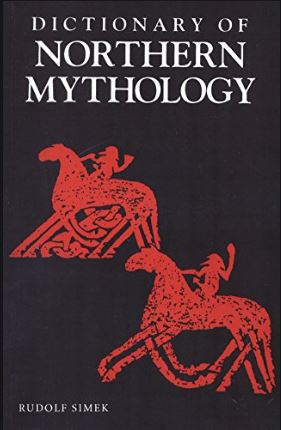
Summary: Simek’s book reads more like an encyclopedia than a dictionary, as some entries are a page or more in length. Simek’s book often gets compared to Lindow’s (below).
Simek’s has more depth and is more sophisticated than Lindow’s book in that in-text citations, cross-references to other entries, and detailed reporting permeate the descriptions.
Some readers may want to utilize Lindow and Simek’s books together or start with Lindow and then move to Simek.
Approach: After a four-page introduction, an abbreviation guide, a short glossary, and a pronunciation guide, the A-Z topical listing begins and continues for 380 pages.
From the publisher: “In compiling this dictionary Rudolf Simek has made the fullest possible use of the information available — Christian accounts, Eddic lays, the Elder Edda, runic inscriptions, Roman authors (especially Tacitus), votive stones, place names, and archaeological discoveries… here are not only tales of the gods, but also of beings from the lower levels of belief: elves, dwarfs, and giants…”
Details:
- Pages: 424
- Level: moderately intermediate when compared to Lindow
- Published: 1983
[Valhalla fascinates people, but it also confuses them. See Is Valhalla Heaven or Hell: 10 Facts That Might Surprise You to learn more.]
2. Norse Mythology: A Guide to Gods, Heroes, Rituals, and Beliefs by John Lindow

Summary: Lindow’s book reads like an entry-level encyclopedia on topics related to Norse mythology. The “pro” is that the book is a great entry point to the topic for those who are new to the figures, events, places, and literature.
The “con” is that those who plan to read widely on this topic will eventually outgrow this resource. However, its easy-to-understand explanations will keep its content evergreen for some readers.
Approach: The majority of the book is an A-Z topical listing of Norse-related topics. The book’s first section is called “Introduction” (35 pages) and discusses the historical background of Norse mythology.
The second section is called “Time” (6 pages) and discusses past, present, and future in Norse mythology. The third, and largest section, is titled, “Deities, Themes, and Concepts” organized in alphabetical order by topic.
From the publisher: “Norse Mythology explores the magical myths and legends of Norway, Sweden, Denmark, Iceland, and Viking-Age — Greenland and outlines the way the prehistoric tales and beliefs from these regions that have remained embedded in the imagination of the world.”
Details:
- Pages: 384
- Level: introductory
- Year published: 2001
[Christianity supplanted Norse Religion in Scandinavia. See the Norse Mythology vs Christianity Comparison Chart to learn more.]
3. Gods and Myths of Northern Europe by H.R. Ellis Davidson
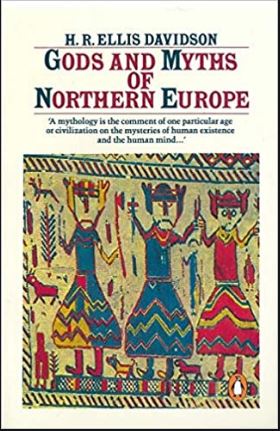
Summary: Davidson’s book gives readers summary descriptions that are based on original sources. Davidson presents information in a way that’s easy to understand, especially those who are new to the topic.
Some readers will wish that Davidson’s descriptions, while based on original sources, interacted with them more.
Approach: After an 18-page introduction, Davidson’s book is divided into sections that are mostly devoted to different deity types. For example: “The Gods of Battle”; “The Gods of the Sea”; “The God of Thunder”; and “The Gods of the Dead.”
Other topics are included as well, including lesser figures like dwarfs, and certain events like the end of the world.
From the publisher: Davidson’s “surveys the pre-Christian beliefs of the Scandinavian and Germanic peoples. Provides an introduction to this subject, giving basic outlines to the sagas and stories, and helps identify the character traits of not only the well known but also the lesser gods of the age.”
Details:
- Pages: 256
- Level: introductory
- Year published: 1965
[Odin is one of the most well-known figures in Norse Mythology. See This Is Why Odin Sacrificed His Eye to learn more.]
4. Norse Myths: Tales of Odin, Thor, and Loki by Crossley-Holland (Author) and Love (Illustrator)
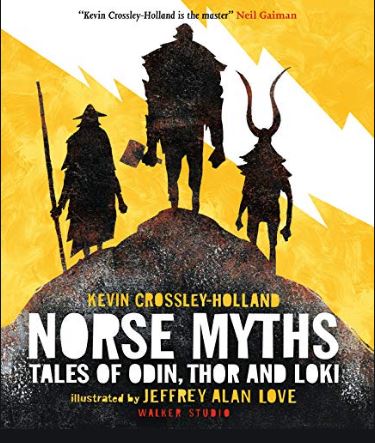
Summary: Fans of this book praise the original art and the dramatic retelling of Norse stories. The content is introductory. The retellings of the old stories have received excellent reviews. Yet the art is what lures and keeps readers interested.
Though the content is foundational, The Wall Street Journal, Kirkus Reviews, and other publications have given the book excellent reviews.
Approach: After a short introduction, the book is mostly organized according to stories. For example, chapter titles include: “Thor Regains His Hammer”; “Baldr’s Dreams”; and “The Last Battle.”
From the publisher: “A collaboration by two talented creators provides the perfect means to delve into Norse mythology and pore over the enthralling exploits of all-powerful Odin; mighty Thor and his hammer, Mjolnir; and Loki, the infamous trickster.
From the creation of the nine worlds to the final battle of Ragnarok, Carnegie Medal winner Kevin Crossley-Holland details the Viking gods as never before, while Jeffrey Alan Love’s lavish illustrations bring the mythic figures to life on the page.”
Details:
- Pages: 240
- Level: introductory
- Year published: 2017
[Is Norse Mythology and Norse religion the same? See Do People Still Practice Norse Religion? to learn more.]
5. Norse Mythology by Neil Gaiman
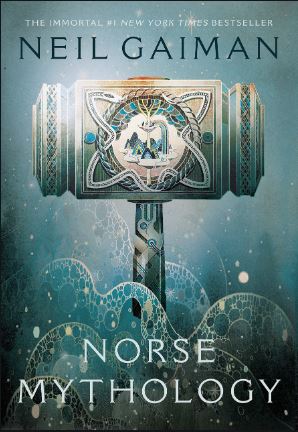
Summary: Popular fiction writer, Neil Gaiman, provides readers with an introductory-level resource on Norse mythology.
Gaiman is not the first writer to introduce contemporary readers to Scandinavian myths through creative retellings, but his approach has resulted in unparalleled commercial success. Gaiman’s writing can be read out loud with ease.
Approach: Scholars and historians may not find many insights in this book, but those who enjoy Norse mythology as a form of entertainment should consider this book. It may become a favorite.
From the publisher: “In Norse Mythology, Gaiman stays true to the myths in envisioning the major Norse pantheon: Odin, the highest of the high, wise, daring, and cunning; Thor, Odin’s son, incredibly strong yet not the wisest of gods; and Loki―son of a giant―blood brother to Odin and a trickster and unsurpassable manipulator.”
Details:
- Pages: 304
- Level: intermediate
- Approach: artistic presentation
6. Myths and Symbols in Pagan Europe: Early Scandinavian and Celtic Religions by H Davidson
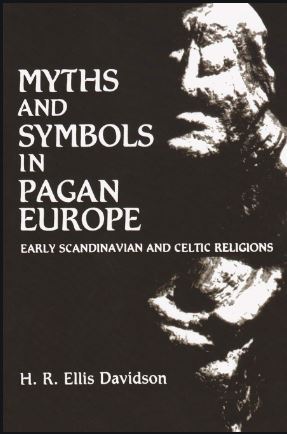
Summary: This book moves beyond the popular-level understanding of Norse mythology to provide the reader with historical descriptions and explanations about the faith of ancient Scandinavians.
Davidson, a well-respected scholar on Norse mythology, pleases readers who want more in-depth treatments on the topic. This book isn’t for entertainment purposes, but for educational ones.
From the publisher: “Most people know of Valhalla, the World-Tree and the gods of Norse mythology, or the strange hunts and voyages of the ancient Irish tales.
Yet, few people realize the significance of the similarities and contrasts between the religions of the pre-Christian people of north-western Europe.
The Celts and Germans and Scandinavians had much in common in their religious practices and beliefs, and this is the first serious attempt that has been made to compare them.”
Details:
- Pages: 268
- Level: intermediate
- Year published: 1988
7. Scandinavian Mythology by H. R. Ellis Davidson
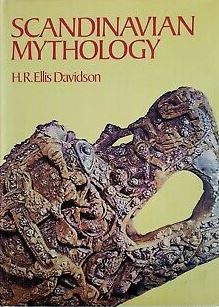
Summary: The respected scholar, H.R. Davidson, wrote this book for non-scholars interested in learning more about Norse mythology. The book is well-known for its illustrations and simple explanations.
Approach: This is a large, thin “coffee table” book that includes many illustrations.
From the publisher: “The author brings vividly to life the world of mighty warriors, ruthless gids, giants, dwarfs, elves, and strange beasts. She shows how Christianity gradually spread and overcame the old religion.
But for many years, stories and carvings showed the two religions strangely intermingled.
Hilda Davidson has made a special study of the archaeology and literature of the Norse people and has written several authoritative works on various aspects of their culture.”
Details:
- Pages: 137
- Level: introductory
- Year published: 1968
8. Dictionary of Norse Myth and Legend by Andy Orchard
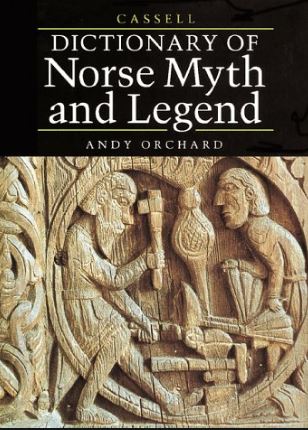
Summary: Orchard’s dictionary is compared to Lindow and Simek’s that preceded it. The book is shorter than the other two, however, it provides the most information on Anglo-Saxon sources of the three titles.
There are 400 topical entries, but they tend to be shorter than Lindow and especially Simek’s.
Approach: A-Z listing like Lindow and Simek. Less overall information is provided to the reader, but more etymological data is given.
From the publisher: “This is an A-Z guide to the mythology of the Vikings, with over 400 articles covering myths, gods and goddesses, giants, dwarves, elves and other supernatural creatures.
It aims to provide an insight into a folklore tradition that has inspired talents as diverse as Wagner and Tolkien.
A general historical introduction provides an overall perspective, and background material on the archaeology and social framework of the Norse world is provided.”
Details:
- Pages: 224
- Level: introductory
- Year published: 1999
9. Tales Of Norse Mythology by Helen A. Gruber
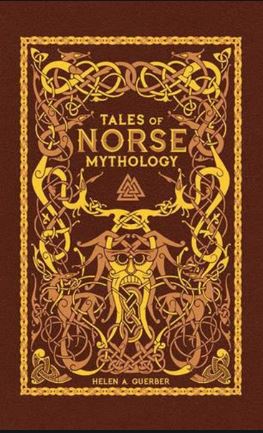
Summary: This is a decorative, hardback book with descriptions and explanations of Norse mythology. Black and white illustrations complement the entries.
The aesthetic of the book will be pleasant to any reader, but the content of the information is introductory. The author, who died in 1929, was an American who enjoyed retelling ancient stories.
From the publisher: “Scandinavians of the Viking Age explored the mysteries of life through their sagas. Folklorist Helen Adeline Guerber brings to life the gods and goddesses, giants and dwarves, and warriors and monsters of these stories in Tales of Norse Mythology.
Ranging from the comic to the tragic, these legends tell of passion, love, friendship, pride, courage, strength, loyalty, and betrayal.”
Details:
- Pages: 464
- Level: introductory
- Year published (this edition): 2017
10. Norse Myths: A Guide to the Gods and Heroes by Carolyne Larrington
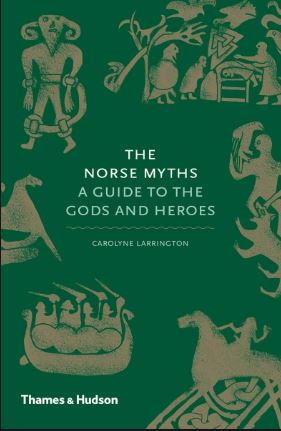
208 pages.
Summary: Larrington introduces modern-day readers to Norse mythology through informed storytelling and accompanying explanations.
Those who are just starting to learn about this topic are the target audience for this book, which has illustrations that accompany many of its descriptions.
From the publisher: “Photographs and drawings show a range of Norse sites, objects, and characters, from Viking ship burials to dragons on runestones.
Dr. Carolyne Larrington describes the Norse myths’ origins in pre-Christian Scandinavia and Iceland, and their survival in archaeological artifacts and written sources, from Old Norse sagas and poems to the less-approving accounts of medieval Christian writers.”
Details:
- Pages: 208
- Level: introductory
- Year published: 2017
Original Resources for Norse Mythology
The common feature in the section below on original sources is that they print ancient Scandinavian sources, translated into English, word-for-word. Beyond that, they may have different features, for example:
- English translations can vary in reading level
- Some translations are complimented with the author’s commentary
- Some publications may include the features above as well as illustrations
1. The Prose Edda: Norse Mythology by Sturluson (Author), Byock (Translator)
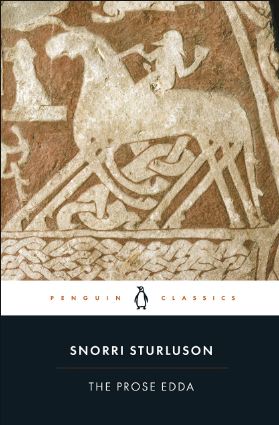
From the publisher: “Written in Iceland a century after the close of the Viking Age, The Prose Edda is the source of most of what we know of Norse mythology. Its tales are peopled by giants, dwarves, and elves, superhuman heroes, and indomitable warrior queens.
Its gods live with the tragic knowledge of their own impending destruction in the cataclysmic battle of Ragnarok.
Its time scale spans the eons from the world’s creation to its violent end. This robust new translation captures the magisterial sweep and startling psychological complexity of the Old Icelandic original.”
Details:
- Pages: 304
- Level: intermediate
2. The Poetic Edda: Stories of the Norse Gods and Heroes by Jackson Crawford
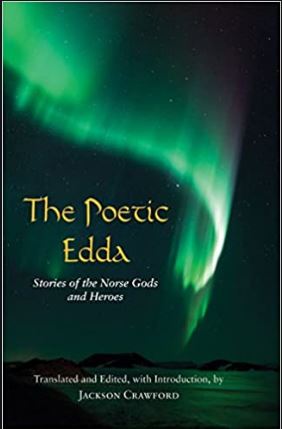
Summary: The Poetic Edda is the present-day name for a collection of poetry that originated in ancient Scandinavia, mostly Iceland.
Most modern readers, because they don’t read Icelandic, can’t read the poems in their original translation, and are dependent upon English translations.
Some translations are inaccessible to some readers because they are written in older English styles (“thees” and “thous”). Jackson’s volume is well-reviewed because he translated the poems into modern English.
Approach: After a brief introduction, there are two sections: (1) Poems about Gods and Elves. Example chapters include: “Lokasenna (Loki’s Taunts)” and “Voluspa en skamma (The Short Prophecy of Ragnarok).” (2) Poems about Heroes.
Example chapters include: “Fafnismal (The Tale of Fanir)” and Helreith Brynhildar (Brynhild’s Ride to Hel).”
From the publisher: “The poems of the Poetic Edda have waited a long time for a Modern English translation that would do them justice. Here it is at last (Odin be praised!) and well worth the wait.
These amazing texts from a 13th-century Icelandic manuscript are of huge historical, mythological, and literary importance, containing the lion’s share of information that survives today about the gods and heroes of pre-Christian Scandinavians, their unique vision of the beginning and end of the world, etc.
Jackson Crawford’s modern versions of these poems are authoritative and fluent and often very gripping.
With their individual headnotes and complementary general introduction, they supply today’s readers with most of what they need to know in order to understand and appreciate the beliefs, motivations, and values of the Vikings.”
Details:
- Pages: 392
- Level: intermediate
- Year published: 2015
3. The Poetic Edda: The Two Volumes in One Book by Henry Adams Bellows
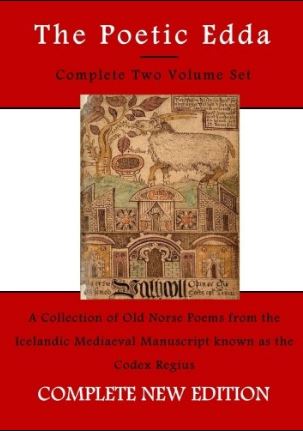
Summary: Bellows worked in print journalism in the first half of the 20th century. He also worked in radio and television. Produced from his own personal interest, Bellows wrote the introduction and provided an original translation for the Poetic Edda.
Details:
- Pages: 310
- Level: intermediate
- Year published: 1923
4. The Poetic Edda by Lee M. Hollander (Translator)
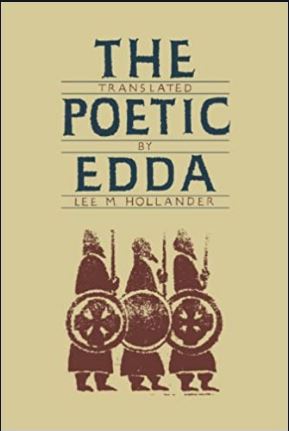
Summary: Lee Hollander, who died in 1947, was a renowned Scandinavian scholar. His translation of the Poetic Edda received excellent reviews upon its publication.
From the publisher: “The Poetic Edda comprises a treasure trove of mythic and spiritual verse holding an important place in Nordic culture, literature, and heritage.
Its tales of strife and death form a repository, in poetic form, of Norse mythology and heroic lore, embodying both the ethical views and the cultural life of the North during the late heathen and early Christian times.”
Details:
- Pages: 376
- Level: intermediate
- 1928 (original edition)
